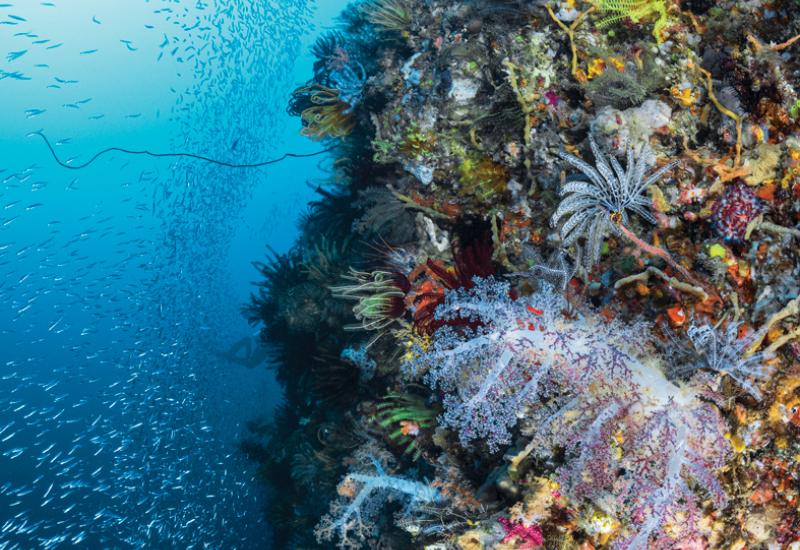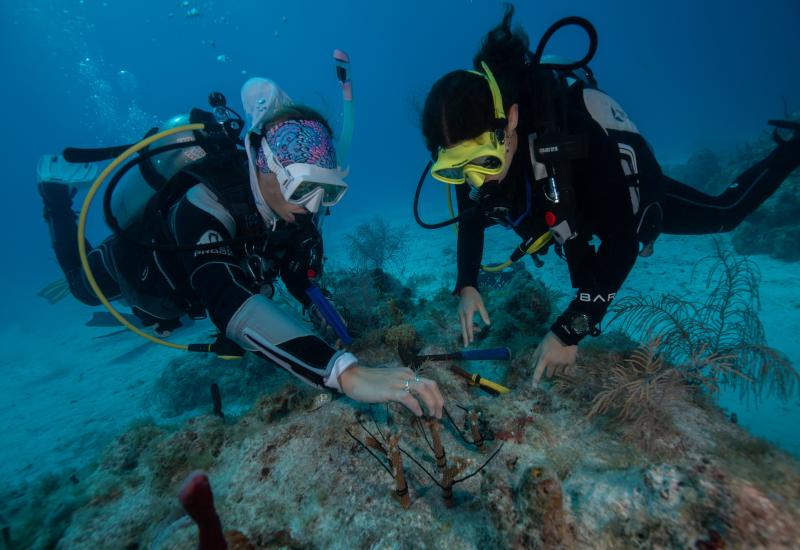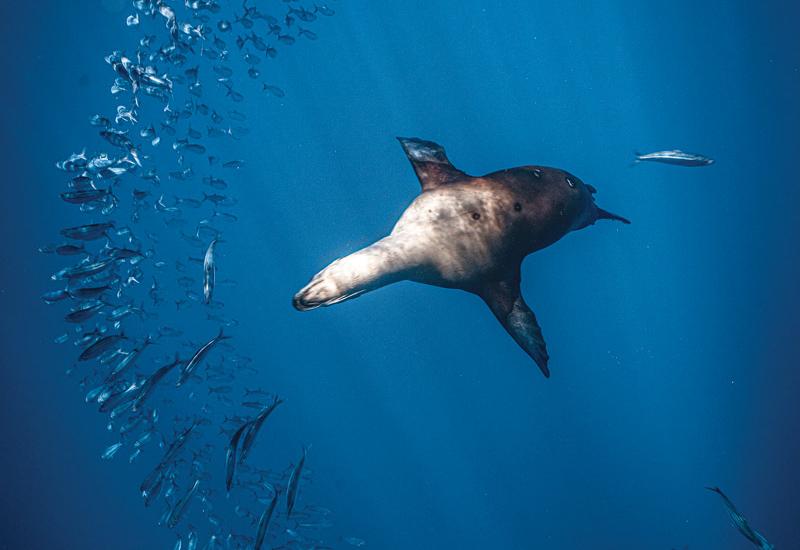Southeast Florida's Wrecks and Oil Rigs
As we approach the site, I can't help but notice that the water looks an unpromising shade of green. But despite the lack of the gin-clear waters divers dream of, the prospect of exploring the wreck of the Captain Dan is still enticing.
Moments later, as I follow the descent line through the water column peppered with particulate, the upper portions of the wreck come into view. Although visibility is in the 50-foot range, it is still easy to make out much of the former 175-foot Coast Guard buoy tender, upright and intact in the 110-foot depths. Above and forward of the wreck's bridge, throngs of grunts and other baitfish dance and sway in the current. Taunting the small, silvery fish, the neighborhood thugs — large barracudas and jacks — make repeated assaults.
Since her sinking in February 1990, the Captain Dan has taken on a coat of marine growth over most of her exterior. Inside, the wreck offers three levels of holds, cabins and corridors for penetration. Dropping in through the starboard entry to the pilothouse, I spin around to compose a shot of the doorway and adjacent window frame. In the brief illumination produced by the camera's twin strobes, something looks odd. Hitting the review button, my question is answered by an image filled with brilliant orange. I take a closer look: Blanketing the wheelhouse's walls, ceiling and window frames are colonies of vivid orange cup corals.
Technically, this coral should not be here. It is non-native to the Caribbean and tropical Atlantic. First recorded in Puerto Rico and Curaçao in 1943, this tropical Pacific native likely found its way into the western Atlantic as a hitchhiker in the belly of large freighters. Since then, this variety of stony coral has slowly spread across the Caribbean from Bonaire to the British Virgin Islands and Jamaica and more recently as far north as southeast Florida and the Gulf of Mexico's Flower Garden Banks.
More Than a Passing FAD
Pick any part of Florida that offers diving, and chances are it will have one particular feature that stands out above any others. The Keys are known for having the most extensive coral reef in North America, while North Palm Beach has large critters — sea turtles, goliath grouper and sharks — as its signature attraction. North Florida is riddled with crystalline pools that lead to deep underground cave systems, and the Gulf is an underwater hunter's paradise. Along Florida's southeast coast, wrecks rule.
Not to be confused with true shipwrecks — vessels foundered by storms, human error or the ravages of war — the wrecks of Florida's Gold Coast were sunk to create fish havens. The area's artificial reefs date to the late 1960s, when a couple of enterprising sportfishermen in Miami recognized the value of placing manmade fish aggregation devices (FADs) to help the declining fisheries in their backyard. The first ship to go down was a 150-foot fuel barge that was sunk in 202 feet of water in 1969. The second vessel, a 110-foot freighter named the Lotus, went down in about 200 feet of water in 1971. In what seemed like no time, the experiment proved successful.
Soon after, Fort Lauderdale and Broward County's Environmental Protection Department (EPD) stepped into the act, with Broward deploying its first wreck, the Osborne, a 60-foot barge in 65 feet of water in 1972. Over the years, Broward County engaged in one of the state's most aggressive artificial reef initiatives, resulting in the creation of more than 112 sites.
Why so many? Unlike the Keys, Broward County harbors a relatively narrow, low-profile reef system, which limits the suitable habitats for marine life. To increase potential fish havens, a significant number of structures needed to be sunk in these waters. For divers, the sweetest fruit to come out of this initiative is the resulting collection of some 40 freighters, barges, tugboats, buoy tenders and a former oil platform that now lie clustered up and down the coast in depths between 60 and 250 feet of water.
Coursing northward through the Florida Straits, the Gulf Stream makes its closest sweep along the state's southeastern coast. This vibrant blue river grazes the Florida Keys and continues past Miami and Fort Lauderdale before taking its closest tack off the Palm Beaches. Within the periphery of this ocean current, sites off Greater Fort Lauderdale, particularly north of Pompano Beach, are sometimes blessed with stellar water quality, making a wreck's mammoth steel skeleton appear to leap off the bottom. However, for the most part visibility is mercurial, averaging between 30 and 60 feet.
Wrecks, Rigs and Fireballs
For Fort Lauderdale and Pompano Beach dive operators, this proliferation of derelict ships is big business, and there is no shortage of offerings to keep divers coming back for more.
The most written-about wreck in the area is the Mercedes I, the infamous 194-foot freighter that was swept onto the beach next to Palm Beach socialite Mollie Wilmot's swimming pool during a violent winter storm in 1984. After being a topside attraction for 105 days, the Mercedes was hauled off to Fort Lauderdale and sunk in 97 feet of water four miles north of the Port Everglades inlet. Today, the wreck has succumbed to the forces of the sea, with just a flattened heap remaining.
One of the top wrecks in this area is the Jim Atria, a 227-foot-long Dutch freighter. In 1987, it was taken four miles north of Port Everglades to be sunk in 135 feet of water. But things didn't go as planned, and instead of landing upright at her targeted depth, she settled on her side in 110 feet of water. When Hurricane Andrew rolled into Miami in 1992, the storm surge not only moved the ship a quarter mile offshore, close to her original target depth of 132 feet, but also managed to place her in an upright position. Still intact after 19 years, her entire hull, aft wheelhouse and twin masts (which give the ship its tallest profile of 70 feet) are covered in blanket corals and sea fans.
Another perennial favorite is the Tenneco Towers. Located off the southernmost point of Fort Lauderdale, near the Dade/Broward county line, the defunct oil-drilling platform offers one of the most unusual vistas in Florida's waters. The reef, donated by the Tenneco Oil Company, consists of two decommissioned production platforms from the Gulf of Mexico. Three of the towers' larger sections were sunk as attractions for divers in depths of 95, 105 and 115 feet of water and rising as much as 50 feet off the bottom.
In August of 1992, the same forces that moved the Jim Atria also carried one section to much greater depths, while leaving the other two almost as they were. But Mother Nature is not one to give up easily. Virtually every square inch of the tower's long-legged formations are under siege. The accumulation of sponge and gorgonian growth has become so dense that the tower's metal surfaces are almost unrecognizable.
In the same league as the Jim Atria in terms of depth, structure and growth is the Rodeo 25. Formerly known as the Windward Trader, this 215-foot freighter was one of several artificial reefs sponsored by the Pompano Fishing Rodeo, a nonprofit fishing tournament, from the 1980s into the 1990s. As part of her sendoff, and in recognition of the Rodeo's 25th anniversary in 1990, the Rodeo 25's hold was loaded with several drums of confiscated ether — the result of several illegal drug lab seizures — which were detonated by the county's bomb squad.
Some 100,000 spectators gathered to watch the fireball created by the ignited ether. Then, as the smoke cleared, the Rodeo 25 slipped below the waves, coming to rest in an upright position in 126 feet of water. Today, with the exception of her middle cargo holds, which have started to buckle, and the 50-foot foremast lying over her starboard rail, her original profile remains intact.
Dive In
Getting There:
Dive charter operators that visit Broward County wrecks are found in close proximity to Boca Inlet (southern Palm Beach County), Hillsboro Inlet (near Pompano Beach) and Port Everglades Inlet (Greater Fort Lauderdale area). From I-95, several eastbound exits can get you (north to south) to various marinas situated close to Boca Inlet (Deerfield Beach), Hillsboro Inlet (Pompano Beach) and Port Everglades Inlet (Fort Lauderdale Beach). Deerfield Beach: Take Hillsboro Blvd. east toward the beaches. Pompano Beach: Take Atlantic Blvd. east toward the beaches. Greater Fort Lauderdale area: Take Las Olas Blvd. (if coming from the south) over the Intracoastal Bridge. If coming from the north, exit I-95 and go east on Sunrise Blvd. to the Intracoastal Waterway and beaches.
To find out more about the Greater Fort Lauderdale area, log on to Hello Sunny where you'll find free vacation planning guides.
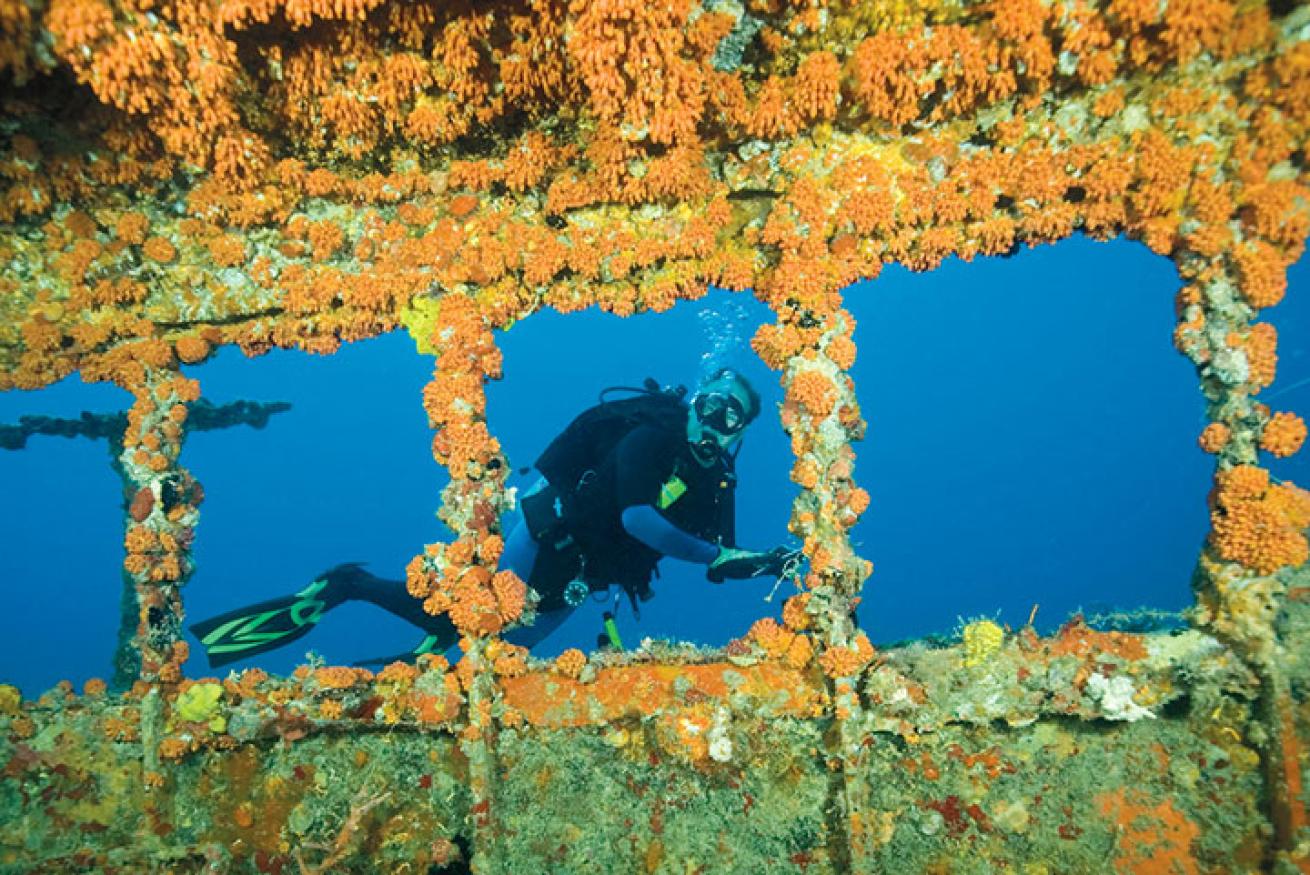
Walt StearnsThe coral-draped skeleton of the Capt. Dan.
As we approach the site, I can't help but notice that the water looks an unpromising shade of green. But despite the lack of the gin-clear waters divers dream of, the prospect of exploring the wreck of the Captain Dan is still enticing.
Moments later, as I follow the descent line through the water column peppered with particulate, the upper portions of the wreck come into view. Although visibility is in the 50-foot range, it is still easy to make out much of the former 175-foot Coast Guard buoy tender, upright and intact in the 110-foot depths. Above and forward of the wreck's bridge, throngs of grunts and other baitfish dance and sway in the current. Taunting the small, silvery fish, the neighborhood thugs — large barracudas and jacks — make repeated assaults.
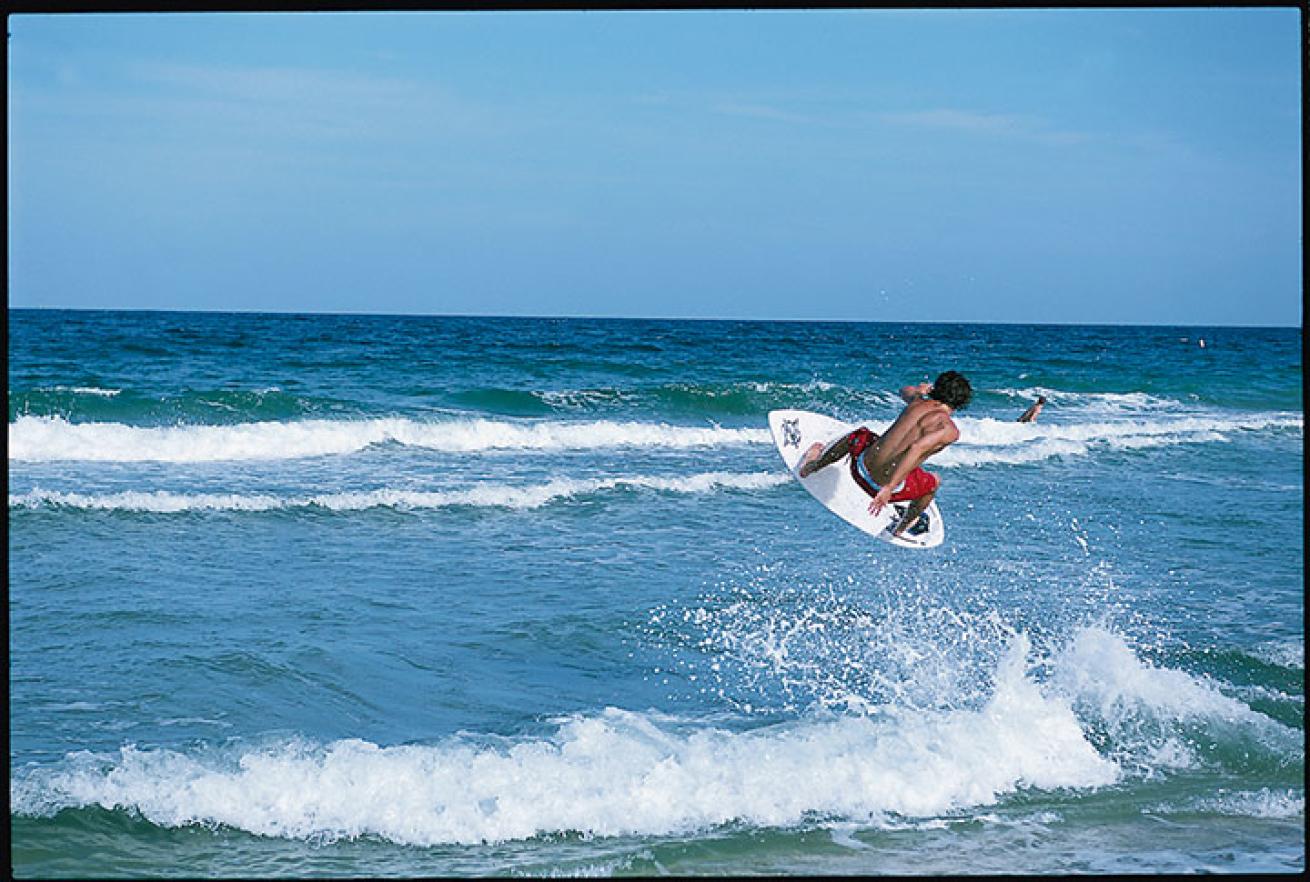
Walt StearnsSkimboarding off Ft. Lauderdale
Since her sinking in February 1990, the Captain Dan has taken on a coat of marine growth over most of her exterior. Inside, the wreck offers three levels of holds, cabins and corridors for penetration. Dropping in through the starboard entry to the pilothouse, I spin around to compose a shot of the doorway and adjacent window frame. In the brief illumination produced by the camera's twin strobes, something looks odd. Hitting the review button, my question is answered by an image filled with brilliant orange. I take a closer look: Blanketing the wheelhouse's walls, ceiling and window frames are colonies of vivid orange cup corals.
Technically, this coral should not be here. It is non-native to the Caribbean and tropical Atlantic. First recorded in Puerto Rico and Curaçao in 1943, this tropical Pacific native likely found its way into the western Atlantic as a hitchhiker in the belly of large freighters. Since then, this variety of stony coral has slowly spread across the Caribbean from Bonaire to the British Virgin Islands and Jamaica and more recently as far north as southeast Florida and the Gulf of Mexico's Flower Garden Banks.
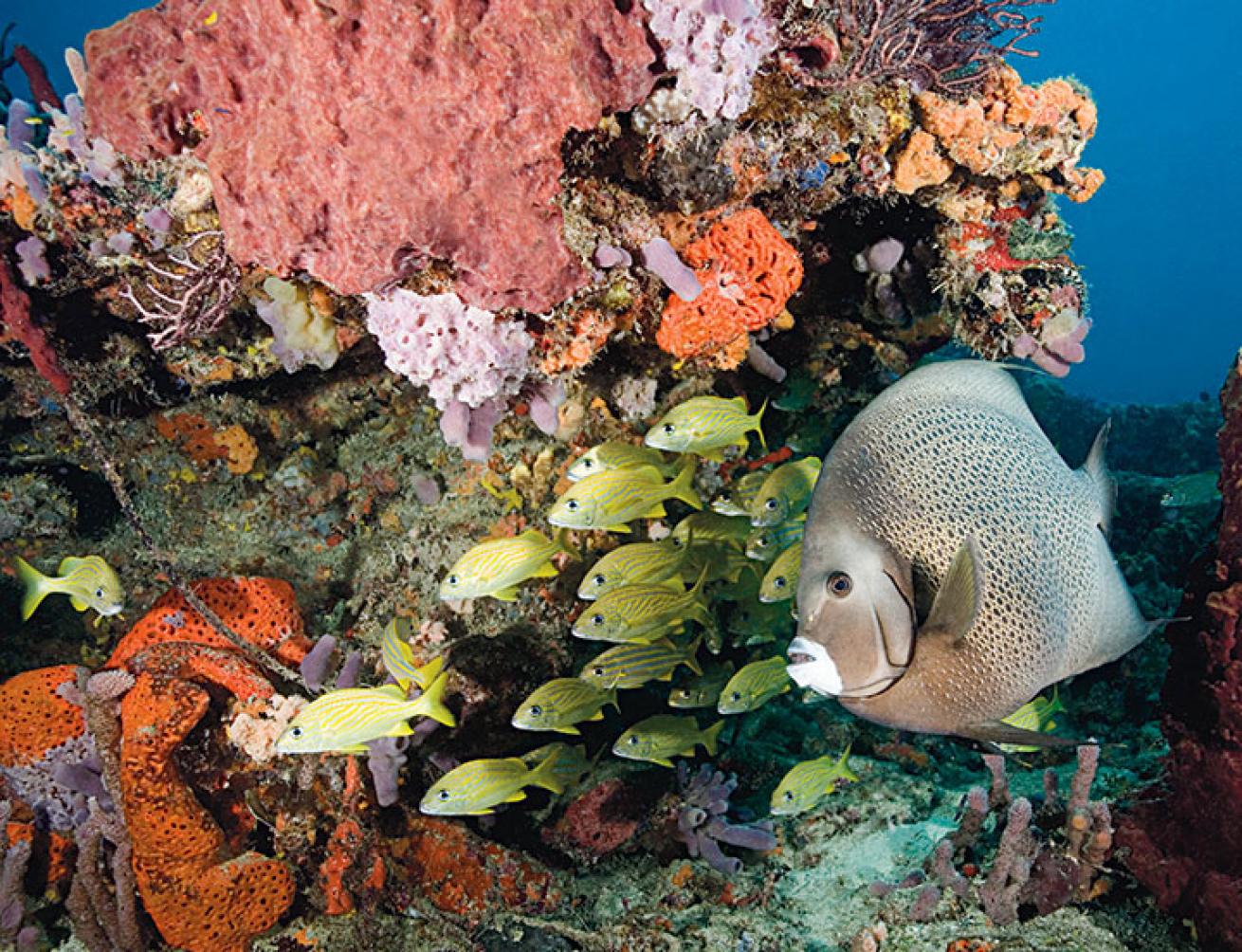
Walt StearnsA gray angelfish on the Capt. Dan.
More Than a Passing FAD
Pick any part of Florida that offers diving, and chances are it will have one particular feature that stands out above any others. The Keys are known for having the most extensive coral reef in North America, while North Palm Beach has large critters — sea turtles, goliath grouper and sharks — as its signature attraction. North Florida is riddled with crystalline pools that lead to deep underground cave systems, and the Gulf is an underwater hunter's paradise. Along Florida's southeast coast, wrecks rule.
Not to be confused with true shipwrecks — vessels foundered by storms, human error or the ravages of war — the wrecks of Florida's Gold Coast were sunk to create fish havens. The area's artificial reefs date to the late 1960s, when a couple of enterprising sportfishermen in Miami recognized the value of placing manmade fish aggregation devices (FADs) to help the declining fisheries in their backyard. The first ship to go down was a 150-foot fuel barge that was sunk in 202 feet of water in 1969. The second vessel, a 110-foot freighter named the Lotus, went down in about 200 feet of water in 1971. In what seemed like no time, the experiment proved successful.
Soon after, Fort Lauderdale and Broward County's Environmental Protection Department (EPD) stepped into the act, with Broward deploying its first wreck, the Osborne, a 60-foot barge in 65 feet of water in 1972. Over the years, Broward County engaged in one of the state's most aggressive artificial reef initiatives, resulting in the creation of more than 112 sites.
Why so many? Unlike the Keys, Broward County harbors a relatively narrow, low-profile reef system, which limits the suitable habitats for marine life. To increase potential fish havens, a significant number of structures needed to be sunk in these waters. For divers, the sweetest fruit to come out of this initiative is the resulting collection of some 40 freighters, barges, tugboats, buoy tenders and a former oil platform that now lie clustered up and down the coast in depths between 60 and 250 feet of water.
Coursing northward through the Florida Straits, the Gulf Stream makes its closest sweep along the state's southeastern coast. This vibrant blue river grazes the Florida Keys and continues past Miami and Fort Lauderdale before taking its closest tack off the Palm Beaches. Within the periphery of this ocean current, sites off Greater Fort Lauderdale, particularly north of Pompano Beach, are sometimes blessed with stellar water quality, making a wreck's mammoth steel skeleton appear to leap off the bottom. However, for the most part visibility is mercurial, averaging between 30 and 60 feet.
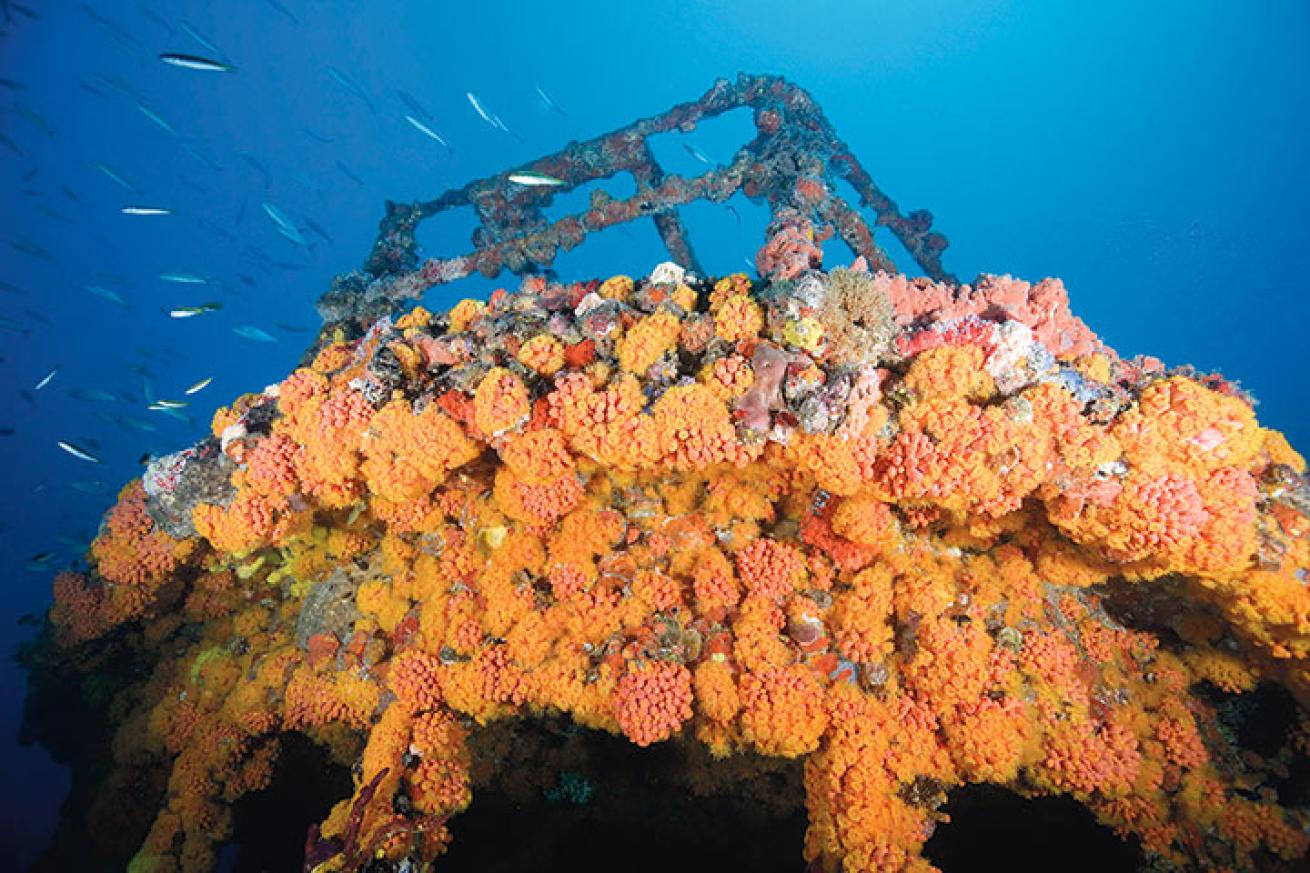
Walt StearnsThe heavily encrusted Capt. Dan.
Wrecks, Rigs and Fireballs
For Fort Lauderdale and Pompano Beach dive operators, this proliferation of derelict ships is big business, and there is no shortage of offerings to keep divers coming back for more.
The most written-about wreck in the area is the Mercedes I, the infamous 194-foot freighter that was swept onto the beach next to Palm Beach socialite Mollie Wilmot's swimming pool during a violent winter storm in 1984. After being a topside attraction for 105 days, the Mercedes was hauled off to Fort Lauderdale and sunk in 97 feet of water four miles north of the Port Everglades inlet. Today, the wreck has succumbed to the forces of the sea, with just a flattened heap remaining.
One of the top wrecks in this area is the Jim Atria, a 227-foot-long Dutch freighter. In 1987, it was taken four miles north of Port Everglades to be sunk in 135 feet of water. But things didn't go as planned, and instead of landing upright at her targeted depth, she settled on her side in 110 feet of water. When Hurricane Andrew rolled into Miami in 1992, the storm surge not only moved the ship a quarter mile offshore, close to her original target depth of 132 feet, but also managed to place her in an upright position. Still intact after 19 years, her entire hull, aft wheelhouse and twin masts (which give the ship its tallest profile of 70 feet) are covered in blanket corals and sea fans.
Another perennial favorite is the Tenneco Towers. Located off the southernmost point of Fort Lauderdale, near the Dade/Broward county line, the defunct oil-drilling platform offers one of the most unusual vistas in Florida's waters. The reef, donated by the Tenneco Oil Company, consists of two decommissioned production platforms from the Gulf of Mexico. Three of the towers' larger sections were sunk as attractions for divers in depths of 95, 105 and 115 feet of water and rising as much as 50 feet off the bottom.
In August of 1992, the same forces that moved the Jim Atria also carried one section to much greater depths, while leaving the other two almost as they were. But Mother Nature is not one to give up easily. Virtually every square inch of the tower's long-legged formations are under siege. The accumulation of sponge and gorgonian growth has become so dense that the tower's metal surfaces are almost unrecognizable.
In the same league as the Jim Atria in terms of depth, structure and growth is the Rodeo 25. Formerly known as the Windward Trader, this 215-foot freighter was one of several artificial reefs sponsored by the Pompano Fishing Rodeo, a nonprofit fishing tournament, from the 1980s into the 1990s. As part of her sendoff, and in recognition of the Rodeo's 25th anniversary in 1990, the Rodeo 25's hold was loaded with several drums of confiscated ether — the result of several illegal drug lab seizures — which were detonated by the county's bomb squad.
Some 100,000 spectators gathered to watch the fireball created by the ignited ether. Then, as the smoke cleared, the Rodeo 25 slipped below the waves, coming to rest in an upright position in 126 feet of water. Today, with the exception of her middle cargo holds, which have started to buckle, and the 50-foot foremast lying over her starboard rail, her original profile remains intact.
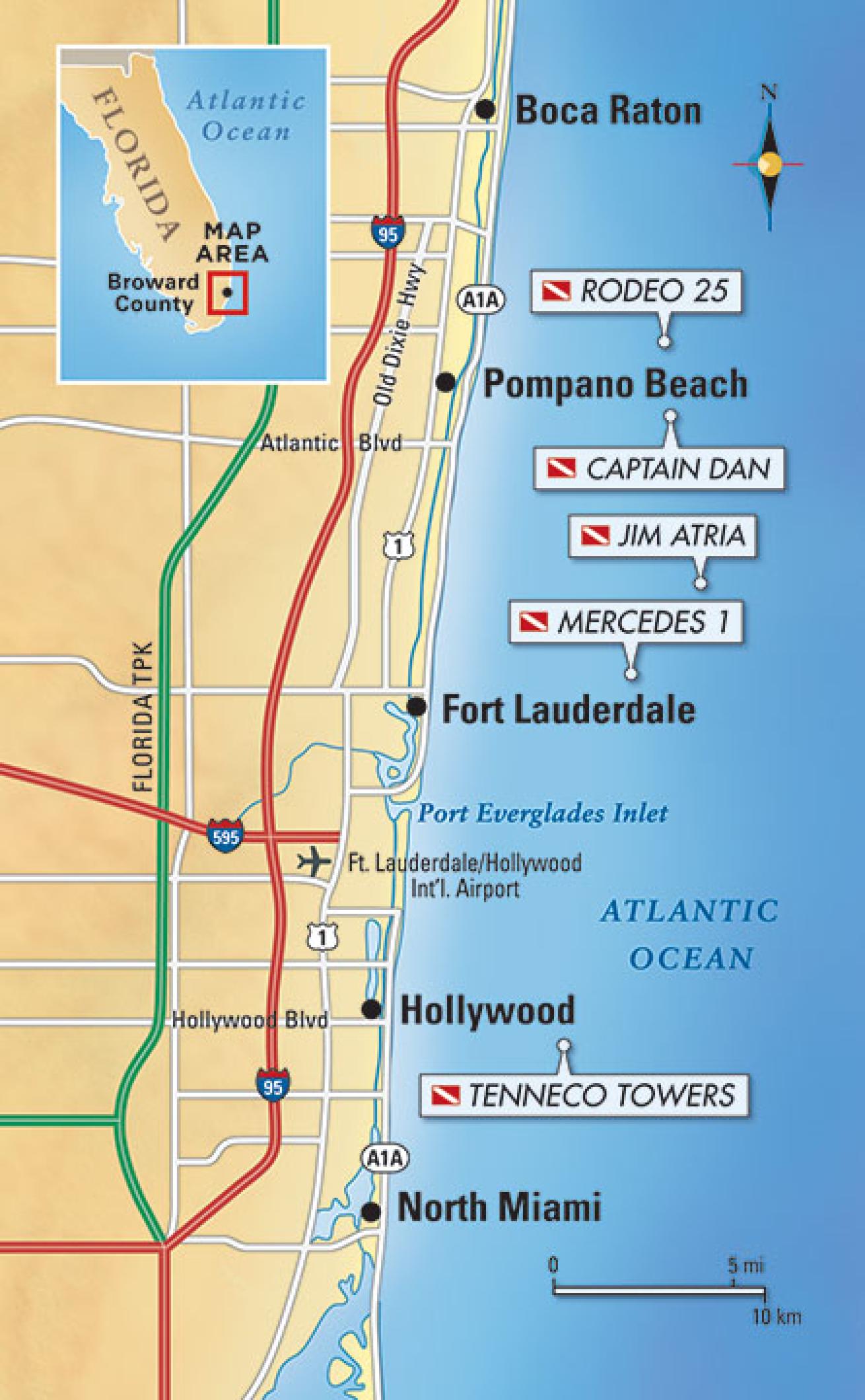
Scuba Diving magazineLocations of the South Florida wrecks and artificial reefs
Dive In
Getting There:
Dive charter operators that visit Broward County wrecks are found in close proximity to Boca Inlet (southern Palm Beach County), Hillsboro Inlet (near Pompano Beach) and Port Everglades Inlet (Greater Fort Lauderdale area). From I-95, several eastbound exits can get you (north to south) to various marinas situated close to Boca Inlet (Deerfield Beach), Hillsboro Inlet (Pompano Beach) and Port Everglades Inlet (Fort Lauderdale Beach). Deerfield Beach: Take Hillsboro Blvd. east toward the beaches. Pompano Beach: Take Atlantic Blvd. east toward the beaches. Greater Fort Lauderdale area: Take Las Olas Blvd. (if coming from the south) over the Intracoastal Bridge. If coming from the north, exit I-95 and go east on Sunrise Blvd. to the Intracoastal Waterway and beaches.
To find out more about the Greater Fort Lauderdale area, log on to Hello Sunny where you'll find free vacation planning guides.


